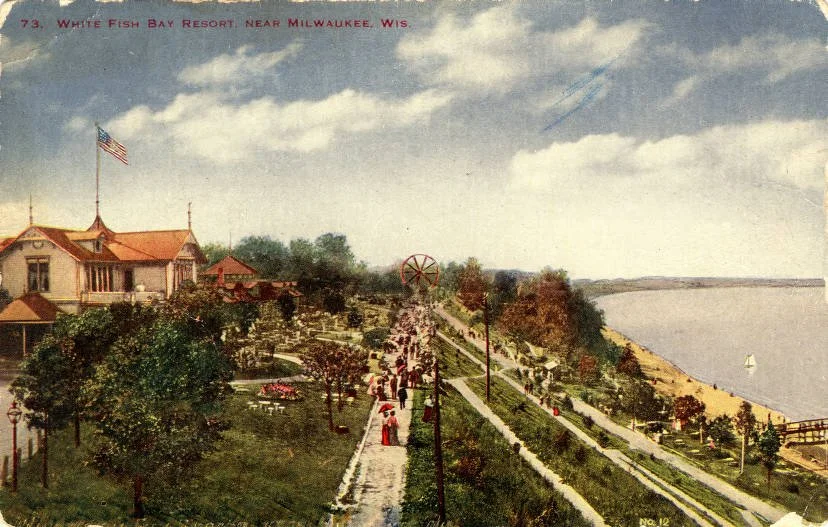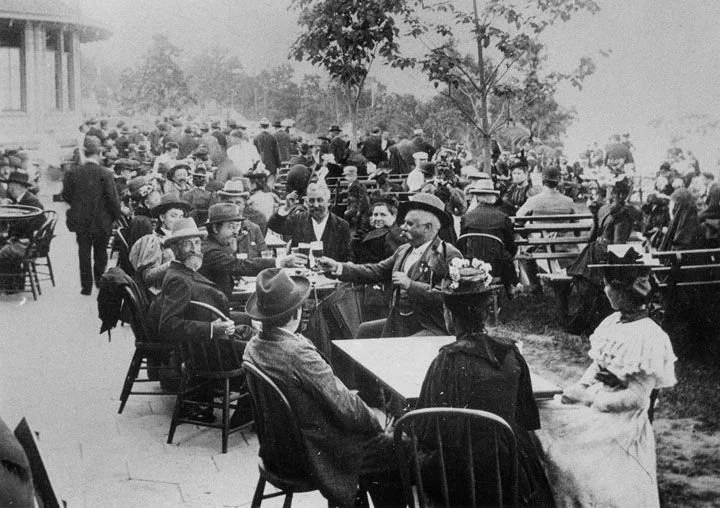The Hidden Stories Behind Whitefish Bay's Street Names
Whitefish Bay Resort. Near Milwaukee, Between 1907 and 1915
Every street name tells a story, and in Whitefish Bay, those stories reveal a fascinating journey from a humble German fishing village to one of Milwaukee's most prestigious lakefront communities. Behind the elegant street signs lie tales of Hollywood glamour, six-year political battles, triple name changes, and a community's ambitious quest to reinvent itself. These naming decisions weren't just administrative choices—they were declarations of identity, aspiration, and sometimes, controversy.
The great Santa Monica Boulevard battle
The most dramatic street naming story in Whitefish Bay history began in 1926, according to Milwaukee Streets: The Stories Behind Their Names.
It started when village officials decided their community needed more "glamorous street names." Fresh from successfully renaming a street to Hollywood Avenue the previous year, they set their sights on transforming the mundane-sounding Richards Street into something more sophisticated: Santa Monica Boulevard.
The name change seemed straightforward—after all, what could be more glamorous than borrowing from Los Angeles' famous Santa Monica Boulevard? But approximately one-fifth of property owners erupted in opposition, claiming they didn't want their street named after St. Monica Catholic Church, which sat right on Richards Street. The objection centered on the Spanish word "Santa" meaning "saint," creating what residents saw as an unwanted religious association.
Village officials protested that the name had nothing to do with the church—they simply wanted to evoke the glamour of California's Santa Monica. But the controversy proved fiercer than anyone expected. The name reverted to Richards Street amid the protests, launching what would become a six-year saga of petitions, letters, heated debates, and the resignation of two village board members.
Finally, in 1932, persistence paid off. Richards Street was permanently renamed Santa Monica Boulevard, marking the end of one of the most contentious naming battles in village history. The victory represented more than just a street name—it symbolized Whitefish Bay's successful transformation from a working-class fishing community to an affluent suburb with Hollywood aspirations.
The mystery of Henry Clay Street
Henry Clay Street has endured more name changes than any other street in Whitefish Bay, and the story behind its final name isn't what most residents would expect. According to local historian Tom Fehring, a member of the Historic Preservation Commission, this particular naming question "had him stumped" until he dug deep into the village's records.
The street's original name was gloriously unwieldy: "Whitefish Bay Port Washington Road"—a mouthful that reflected its function as part of the private toll road system connecting to the famous Pabst Whitefish Bay Resort. In 1919, as the community formalized its street system, officials simplified it to "Washington Avenue." But that name lasted only seven years.
In 1926, the street was renamed "Henry Clay Street," and here's where the story gets interesting. Most residents assume it honors Henry Clay, the famous Kentucky statesman known as "The Great Compromiser." But Fehring discovered the real story: the street was actually named after Henry Clay Middle School, built in 1918 after the original Whitefish Bay School burned down in 1917.
The school sat on the street, and residents were already informally calling it "Henry Clay Street." Village officials simply made the informal name official. So while the street does technically honor the Kentucky politician, it was named for the school, not the man directly—a subtle distinction that illustrates how local institutions often drive naming decisions.
From whitefish to gold coast
The community's very name reveals its lakefront origins. Whitefish Bay derives from the abundant whitefish that early German settlers caught in the adjacent bay of Lake Michigan. These commercial fishing operations established the area's first economic foundation, and according to the Wisconsin Historical Society, "the frequency with which they caught whitefish there suggested a name for the community."
The Native American heritage runs even deeper. In the Chippewa language, the area was called "Atikamego-wikwedong," meaning "at, to, from, white fish bay," derived from "atikameg" (a white fish) and "wikwedong" (bay). This linguistic connection to the lake's natural resources shaped the community's identity from its earliest days.
As the village evolved, Lake Drive became the crown jewel of addresses, running directly along the Lake Michigan shoreline. Originally part of a private toll road connecting to the Pabst Whitefish Bay Resort, this street transformed into the backbone of what became known as the "gold coast"—a stretch of affluent lakefront communities north of Milwaukee.
The resort itself tells a remarkable story. Captain Frederick Pabst, owner of the Pabst Brewing Company, invested $30,000 in 1889 to create the Whitefish Bay Resort, complete with hotel, restaurant, beer garden, bandshell, Ferris wheel, and carousel. The resort attracted up to 15,000 visitors on weekends and even hosted President Theodore Roosevelt. When it closed in 1914, the 17 lakefront lots were developed into luxury residences, including the Herman Uihlein Mansion (1919), built for a son of the Joseph Schlitz Brewing Company president.
Silver Spring: Railway Origins, Not Natural Springs
In the 1870s, Green Bay Road was the main route from Milwaukee to Green Bay, but the yet-to-be-named Silver Spring road was sparsely used. It was short, starting at the Milwaukee River and ending at Teutonia Avenue. Its major users were local farmers.
That all changed when the Chicago and North Western Railway extended its tracks from Milwaukee to St. Paul, Minnesota, passing near this intersection, where the company erected a passenger station. According to Carl Baehr's research in "Milwaukee Streets: The Stories Behind Their Names," a railway superintendent named the railroad stop "Silver Springs" because a nearby brick manufacturer claimed his factory had "silver springs"—likely referring to water used in brick production rather than natural springs.
Spring Springs became the name of a thriving nearby community known for ice harvesting, bicycle clubs and even a baseball team.
During the 1890s, the street carried different names for different sections: "Silver Spring Road" on the western side and "Silver Spring Avenue" in Whitefish Bay, separated by the Milwaukee River with no connecting bridge. Between 1917 and 1931, all sections were unified under the name "Silver Spring Drive," creating the continuous arterial street that exists today. This timing coincided with Whitefish Bay's major growth period, when the village population grew tenfold between 1917-1936.
As for the Chicago and North Western Railway route that led to the naming of Silver Spring Dr., it is now part of the Oak Leaf Trail.
English elegance and aspirational naming
The village's street names reveal a clear pattern of aspirational naming, particularly evident in the English geographic references. Marlborough Drive evokes Marlborough, a town in England. These names reflect the educated, literary aspirations of early 20th-century developers who wanted to create an atmosphere of culture and refinement.
This English theme likely wasn't accidental. During the 1920s and 1930s, American suburban developers frequently borrowed prestigious European place names to suggest sophistication and upper-class aspirations. Whitefish Bay's developers understood that names like Marlborough conveyed a sense of established elegance that would appeal to Milwaukee's growing professional class.
The school-driven community
Whitefish Bay's incorporation in 1892 was driven by education, not politics. George Rogers, publisher of the Whitefish Bay Pioneer, led the campaign for village status primarily because residents wanted local schools. This educational focus influenced street naming from the beginning, with several streets named after schools or educational institutions.
The connection between schools and street names creates a unique local character. Richards Street (now Santa Monica Boulevard) was the location of Richards Elementary School, preserving the original street name even after the boulevard transformation. This pattern of school-street naming relationships reflects the community's enduring commitment to education as a defining characteristic.
Hollywood dreams and California aspirations
The 1920s marked a fascinating period when Whitefish Bay officials actively pursued what they called "more glamorous street names." The successful 1925 renaming of Hollywood Avenue set the stage for the Santa Monica Boulevard battle, reflecting the community's fascination with California's growing reputation for luxury and entertainment.
This California theme wasn't unique to Whitefish Bay. Throughout the Milwaukee area, communities were adopting street names from famous American cities, borrowing prestige from places like Bourbon Street, Beale Street, and Euclid Avenue. The pattern reflected broader American suburban aspirations during the 1920s, when prosperity and Hollywood glamour seemed within reach of middle-class communities.
The streetcar suburb legacy
Whitefish Bay developed as a classic streetcar suburb, connected to Milwaukee by the Milwaukee & Whitefish Bay Railway, known locally as the "Dummy Line." This steam-powered railroad, later replaced by electric streetcars, shaped both the community's development pattern and its street layout.
The transportation connection influenced naming decisions by creating a commuter-oriented community that needed to balance local identity with regional accessibility. Streets like Diversey Boulevard share names with well-known Chicago streets, reflecting the broader Midwest's interconnected urban development patterns.
Preserving the past while embracing change
Today, Whitefish Bay's street names preserve the stories of its transformation from a German fishing village to an affluent lakefront suburb. The names reveal community values: respect for education (Henry Clay Street), appreciation for natural beauty (Silver Spring Drive, Lake Drive), aspirations for sophistication (Marlborough Drive), and even a touch of Hollywood glamour (Santa Monica Boulevard).
These naming decisions weren't just administrative choices—they were declarations of community identity. The six-year battle over Santa Monica Boulevard demonstrates how deeply residents care about their community's image and character. The multiple name changes of Henry Clay Street show how local institutions can gradually influence public spaces.
For today's residents, these street names serve as daily reminders of their community's rich history. Every time someone drives down Santa Monica Boulevard, they're traveling a street that represents six years of civic passion. Every address on Lake Drive connects to the area's resort heritage and lakefront natural beauty.
The stories behind Whitefish Bay's street names reveal a community that has successfully balanced preservation with progress, local identity with broader aspirations, and practical needs with aesthetic vision. These names don't just help us navigate the village—they help us understand how this unique lakefront community came to be.





Looking for a festive family outing that combines holiday magic with a hearty breakfast? Mark your calendars for the Kiwanis Pancake Breakfast with Santa on Saturday, December 13th at Dominican High School in Whitefish Bay.